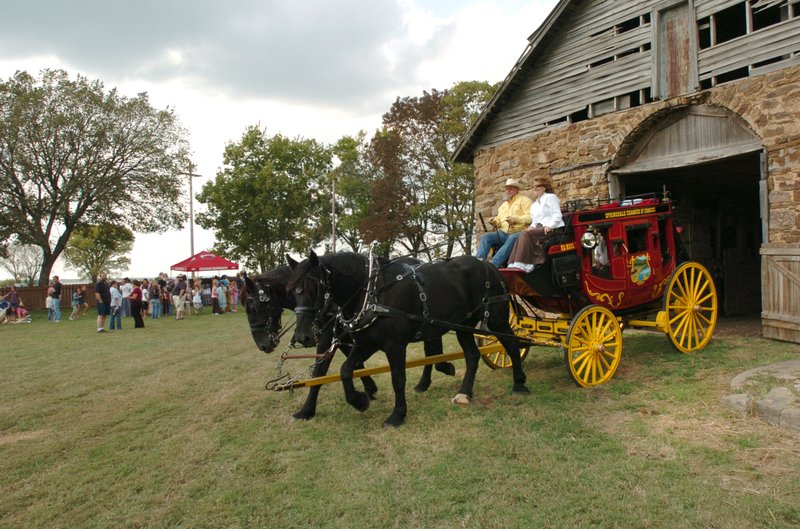First the Osage Indians used the trail for hunting game. The trail evolved over time, and the military marched it and fought for it during the Civil War. Later, the telegraph wires followed the road. In the early 1880s, the St. Louis-San Francisco Railway laid its rail from Monet, Mo., to Fort Smith along a very similar route. And today's Interstate 49 follows the path.
When it came time for John Butterfield to choose a trail for his stagecoach mail route, he chose the same road. It was long-established, said Ken O'Donnell, a retired metropolitan planner.
Go & Do
Crawford County Chronicles
Butterfield Overland Mail Route
When: 1:30 p.m. and 3 p.m. July 6
Where: Drennen-Scott Historic Site, North Third Street, Van Buren
Admission: Free
Information: 262-2750, [email protected]
O'Donnell speaks at 1:30 p.m. and 3 p.m. July 6 at the Drennen-Scott Historic Site in Van Buren, as a part of the Crawford County Chronicles series.
An Act of Congress in 1857 granted the postmaster general the right to contract the delivery of mail from the Mississippi River to California. John Butterfield won the bid with his Butterfield Overland Mail Route. Mail for the run was collected in Little Rock and St. Louis, then carried to Tipton, Mo., the origination of the stage. The two lines met in Fort Smith and traveled south.
"On Sept. 16, 1858, a single stage left Tipton, Mo., on its first journey to San Francisco," writes Kirby Sanders in "The Driver's Guide to the Butterfield Overland Mail Route: Volume One, Missouri, Arkansas and Oklahoma."
Butterfield originally considered have the mail collected in Memphis, Tenn., but the river crossing proved to be too arduous, O'Donnell said. Instead, the stage crossed the Boston Mountains.
"At Parks' Station (near Hogeye), mules were hitched rather than horses for the hard pull up, through and over the Boston Mountains," Sanders wrote.
"I had thought before we reached this point (the Boston Mountains) that the rough roads of Missouri and Arkansas could not be equaled; but Arkansas fairly beat itself," O'Donnell quoted Waterman L. Ormsby, a reporter who rode from St. Louis to San Francisco in that inaugural mail run. "The Adirondack Mountains are but a mere pimple compared to the Ozarks (Boston Mountains)."
O'Donnell, along with the Heritage Trail partners, set out to find the stagecoach's exact route through Northwest Arkansas.
They relied on early maps made by the Government Land Office. The Butterfield showed up in 1860s, O'Donnell reported. Surveyors' logs provided another source of information, as did family histories.
"They would talk about a rock outcropping, but we knew it wasn't the same place because it was there on Lee Creek," O'Donnell said.
"A lot of people think it went through Devil's Den because mail was being delivered there," he continued, "but that's just not right."
A current road map from the Arkansas State Highway and Transportation Department overlaid on a map of the stage route "pointed to what (the route) had to be," O'Donnell said.
"Butterfield decided he would go the most direct route because of the need for speed," he said. Congress gave Butterfield just 25 days to get the mail to California. "So (the stage) was moving as fast as it could -- about 70 miles a day," O'Donnell continued, "with a pickup here and there. He had only a year to get horses, determine stations and get the stage route moving. He used the established trail because he didn't have time to clear a new trail."
The trail entered Arkansas south of Washburn, Mo., with an unofficial stop at Elkhorn Tavern, now part of the Pea Ridge National Military Park. Other Northwest Arkansas stops included Callahan's Station on today's Spruce Street in Rogers; Fitzgerald's Station on Old Wire Road in Springdale; the Fayetteville Station, at the site of the 1906 Washington County Courthouse; Park's Station in Hogeye; and Strickland Station at Strickler.
"Brodie's Station was the northernmost point in Crawford County," O'Donnell said. The stage then traveled through Woosley's Station, south of Cedarville; to the 1842 Crawford County Courthouse in Van Buren; to the Old Van Buren Ferry Landing on the Arkansas River. The stage arrived at the site of Fort Smith and the federal courthouse for the Western District of Arkansas, consolidated mail from the Little Rock route and crossed into Choctaw land in Indian Territory (now Oklahoma.
"(The stage routes) met in Fort Smith," O'Donnell said. "It was a quartermaster area, the largest city west of Little Rock to California."
Today, the stagecoach trails run parallel to the roads, in sight of traffic. Parts of the original trail remain in the Ozark National Forest areas.
"It's amazing," O'Donnell said. "Nothing has changed. You get a sense of what it was like then. You might see the same things as you drive along that the passengers might have seen."
NAN Life on 06/25/2014
